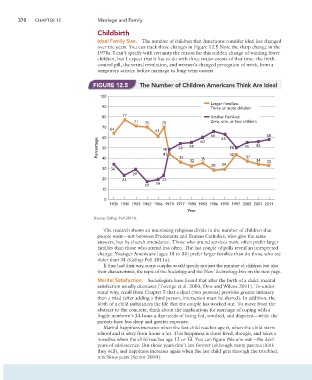Page 405 - Essencials of Sociology
P. 405
378 CHAPTER 12 Marriage and Family
Childbirth
Ideal Family Size. The number of children that Americans consider ideal has changed
over the years. You can track these changes in Figure 12.5 Note the sharp change in the
1970s. I can’t specify with certainty the reason for this sudden change of wanting fewer
children, but I expect that it has to do with three major events of that time: the birth
control pill, the sexual revolution, and women’s changed perception of work, from a
temporary activity before marriage to long-term careers.
FIGURE 12.5 The Number of Children Americans Think Are Ideal
100
Larger Families:
90 Three or more children
80 77 Smaller Families:
71 70 70 Zero, one, or two children
70
64
61
66 63 58
60
Percentage 50 48 54 55 60 42 55 56
50
43
36
40
32 35 37 34 33
28 29
30 34
29
20 23 23
19
17
10
0
1936 1945 1953 1962 1966 1973 1977 1980 1983 1986 1990 1997 2003 2007 2011
Year
Source: Gallup Poll 2011b.
The research shows an interesting religious divide in the number of children that
people want—not between Protestants and Roman Catholics, who give the same
answers, but by church attendance. Those who attend services more often prefer larger
families than those who attend less often. The last couple of polls reveal an unexpected
change: Younger Americans (ages 18 to 34) prefer larger families than do those who are
older than 34 (Gallup Poll 2011a).
If they had their way, some couples would specify not just the number of children but also
their characteristics, the topic of the Sociology and the New Technology box on the next page.
Marital Satisfaction. Sociologists have found that after the birth of a child, marital
satisfaction usually decreases (Twenge et al. 2003; Dew and Wilcox 2011). To under-
stand why, recall from Chapter 5 that a dyad (two persons) provides greater intimacy
than a triad (after adding a third person, interaction must be shared). In addition, the
birth of a child unbalances the life that the couple has worked out. To move from the
abstract to the concrete, think about the implications for marriage of coping with a
fragile newborn’s 24-hour-a-day needs of being fed, soothed, and diapered—while the
parents have less sleep and greater expenses.
Marital happiness increases when the last child reaches age 6, when the child starts
school and is away from home a lot. This happiness is short-lived, though, and takes a
nosedive when the child reaches age 12 or 13. You can figure this one out—the devil
years of adolescence. But those years don’t last forever (although many parents think
they will), and happiness increases again when the last child gets through the troubled,
rebellious years (Senior 2010).

